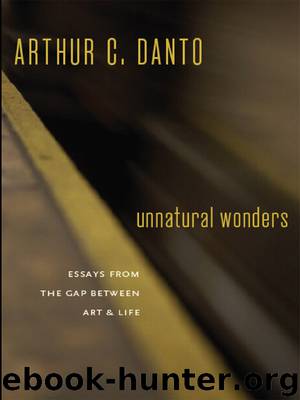Unnatural Wonders by Arthur C. Danto

Author:Arthur C. Danto
Language: eng
Format: epub
Tags: PHI001000, Philosophy/Aesthetics, ART015000, Art/History/General
Publisher: Columbia University Press
Published: 2007-10-05T04:00:00+00:00
I have followed Newman in respecting a distinction between pictures and paintings. Onement 1 was a painting, whereas what he had done before were merely pictures. How are we to understand the difference? My own sense is that a picture creates an illusory space, within which various objects are represented. The viewer, as it were, looks through the surface of a picture, as if through a window, into a virtual space, in which various objects are deployed and composed: the Virgin and Child surrounded by saints in an adoration; stripes surrounded by squiggles in an abstraction. In the Renaissance, a picture was regarded as transparent, so to speak, the way the front of the stage is, through which we see men and women caught up in actions that we know are not occurring in the space we ourselves occupy. In a painting, by contrast, the surface is opaque, like a wall. We are not supposed to see through it. We stand in a real relationship with it, rather than in an illusory relationship with what it represents. I expect that this is the distinction Newman is eager to make. His paintings are objects in their own right. A picture represents something other than itself; a painting presents itself. A picture mediates between a viewer and an object in pictorial space; a painting is an object to which the viewer relates without mediation. An early work that externally resembles Onement 1 is Moment, done in 1946. A widish yellow stripe bisects a brownish space. Newman said of it, “The streak was always going through an atmosphere; I was trying to create a world around it.” The streak in Onement 1 is not in an atmosphere of its own, namely, pictorial space. It is on the surface and in the same space as we are. Painting and viewer coexist in the same reality.
At the same time, a painting is not just so much pigment laid across a surface. It has, or we might say it embodies, a meaning. Newman did not give Onement 1 a title when it was first exhibited, but it is reasonable to suppose that the meaning the work embodied was somehow connected with this strange and exalted term. In general, the suffix “-ment” is attached to a verb like “atone” or “endow” or “command,” where it designates a state—the state of atoning, for example—or a product. So what does “onement” mean? My own sense is that it means the condition of being one, as in the incantation “God is one.” It refers, one might say, to the oneness of God. And this might help us better understand the difference between a picture and a painting. Since Newman thinks of himself and Michelangelo as concerned with the same kinds of problems, consider the Sistine ceiling, where Michelangelo produces a number of pictures of God. Great as these are, they are constrained by the limitation that pictures can show only what is visible, and decisions have to be made regarding what God looks like.
Download
This site does not store any files on its server. We only index and link to content provided by other sites. Please contact the content providers to delete copyright contents if any and email us, we'll remove relevant links or contents immediately.
The Secret History by Donna Tartt(18232)
Red Sparrow by Jason Matthews(5204)
Harry Potter 02 & The Chamber Of Secrets (Illustrated) by J.K. Rowling(3559)
In a Sunburned Country by Bill Bryson(3378)
Drawing Cutting Edge Anatomy by Christopher Hart(3304)
Figure Drawing for Artists by Steve Huston(3277)
Harry Potter and the Prisoner of Azkaban (Book 3) by J. K. Rowling(3126)
The Daily Stoic by Holiday Ryan & Hanselman Stephen(3116)
Japanese Design by Patricia J. Graham(3006)
The Roots of Romanticism (Second Edition) by Berlin Isaiah Hardy Henry Gray John(2826)
Make Comics Like the Pros by Greg Pak(2767)
Stacked Decks by The Rotenberg Collection(2701)
Harry Potter and the Deathly Hallows (7) by J.K. Rowling(2556)
Draw-A-Saurus by James Silvani(2516)
Tattoo Art by Doralba Picerno(2498)
On Photography by Susan Sontag(2495)
Foreign Devils on the Silk Road: The Search for the Lost Treasures of Central Asia by Peter Hopkirk(2392)
Churchill by Paul Johnson(2374)
The Daily Stoic by Ryan Holiday & Stephen Hanselman(2354)
